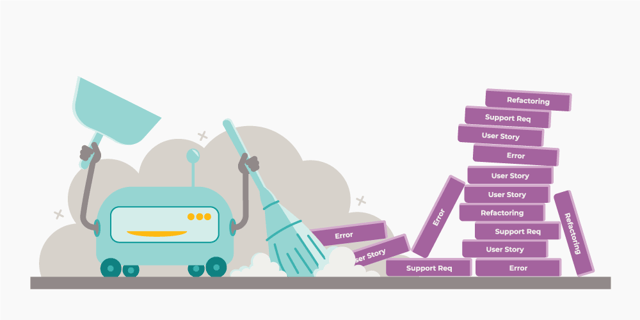Product leaders should take initiative to tackle product backlogs before they spiral out of control. Too large a backlog can stand in the way of creativity and innovation, making it essential for teams to keep their list at an ideal size. To help with this process, I've included some inspiring tools that could be leveraged as well – all found at the end of this blog!
Using robots may lead to trusting the system too much
It can be tempting to use robots and rules to try and manage your backlog size, but this approach should not be taken lightly. Automation can cause people to put too much trust in the system - leading product leaders blindly populate the backlog with feedback, requests, and new feature ideas without thoroughly evaluating them first. As a result, it’s important that such processes are done manually by human personnel for maximum effectiveness.
In my previous blog, I recommended using this approach of separating work for your:
- Backlog (high commitment, short time window)
- Roadmap (longer time window)
- Wishlist (low commitment)
Product leaders should carefully review each item on the backlog, only granting acceptance to those of great value. Wishlist instead should be used for the collection of new ideas.
What role does a Product Owner play?
Use a clear workflow state to indicate backlog acceptance
Product Owners need to hold a tight control over the backlog. If anyone can enter items onto the backlog then there needs to be a workflow state transition (e.g., “New” to “Approved”) that marks the real backlog acceptance. Product Owners then have to set up regular time to review the new suggestions.
Control the rights with the tool
If the POs are actually the only ones allowed to enter items to the backlog, then I would actually prefer controlling the rights of the tool in a way that makes this the case. That’s why everyone who wants to suggest an item to be on the backlog must first talk to the Product Owners.
Backlog cleaning robots will reduce critical questions for backlog acceptance
Product Owners play a critical role within organizations, where they are responsible for evaluating every item in the backlog and determining its value to meet product goals. It’s their responsibility to ask as many questions about each task as possible so that any underlying needs can be uncovered and addressed. If the team has a “Backlog Roomba”, it allows the PO to be less critical of the backlog acceptance, which inevitably leads to backlog growth. Instead of being simply on the backlog, what matters now is how close an item gets to the top - its position and priority can mean all the difference.
Review robot generated cleaning lists
The situation gets especially bad if the robot’s just removing the old items. If the robot proposes an idea, it’s good to review any items that are older first. However for more comprehensive decision-making, organizing a meeting with core stakeholders like architects, designers and product managers can be beneficial in reordering the backlog, based on age or last edited time frame; this will enable prioritizing of tasks according to importance.
Read more about backlog management
Backlog maintenance is important enough to merit spending time
To effectively manage a backlog, its paramount teams conduct regular review sessions. This approach is far more effective than attempting a robotic solution – allowing for thoughtful resolution and addressing any potential issues in an ongoing manner. These sessions can also provide benefits other than backlog cleaning, such as:
- Allowing you to focus on planning the future, next quarter, and the quarter after that.
- Observing the maturity of items on the roadmap, and what kind of tests, studies, and design work your teams need before making a decision on if they should be graduated to the backlog.
- Cleaning out the items from the roadmap and backlog that are unlikely to get done.
It’s far better to “clean together” than to trust a robot and/or leave the Product Owners alone in tackling an overflowing backlog.
To maintain a manageable backlog size, regular maintenance is essential. Jira queries are an effective way to track and control items in the queue, but robotics aren't quite up-to-date enough yet for full automation of this process. Taking time out regularly to tidy things up can greatly benefit project outcomes - humans still have some tasks left in their hands!
Published: May 17, 2023


